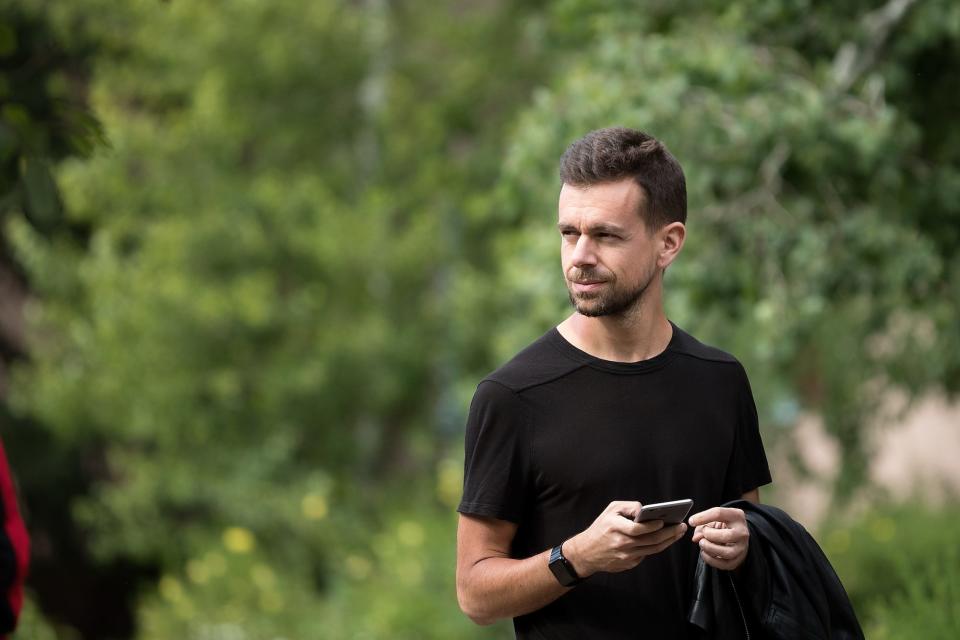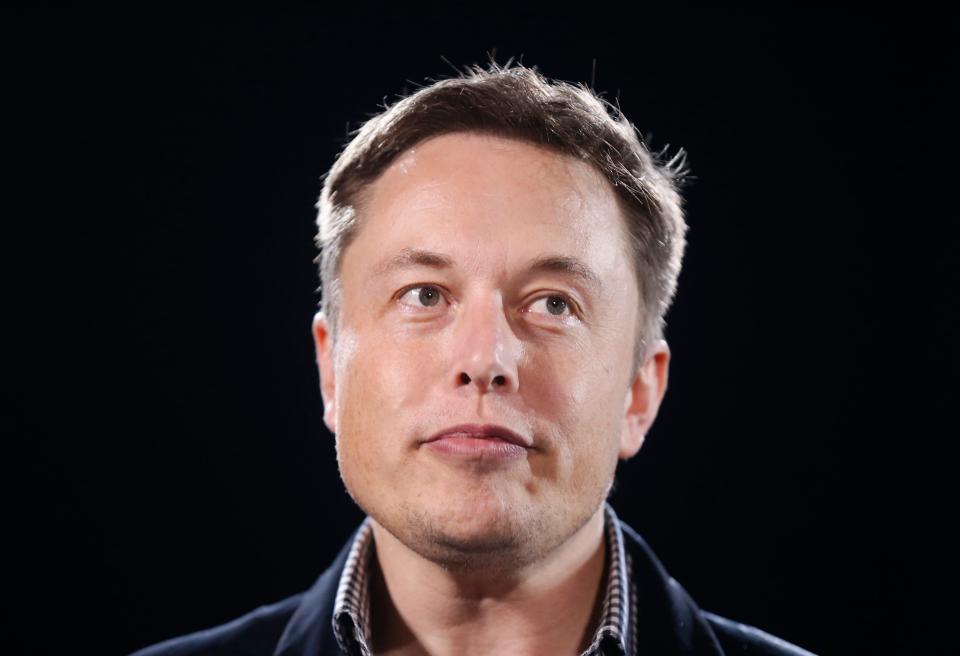A behind-the-scenes look at the Twitter company retreat that brought Jack Dorsey out of his shell
Jack Dorsey once led a Twitter company retreat to boost employee morale and set a vision for the company.
The 3-day event featured strange wellness routines, dance parties, and a special message from no-show guest Elon Musk.
The following is an excerpt from "Battle for the Bird," a new book by journalist Kurt Wagner.
Jack Dorsey sat on the floor with his legs crossed and his back straight, silently meditating on a stage inside one of San Francisco's largest convention halls.
High above him, the blue lights inside the Moscone Center had dimmed. Behind him, a white Twitter bird sat motionless in the middle of a giant, purple video screen.
Had Dorsey opened his eyes, he would have seen nearly all of Twitter's 3,500 employees facing him in their own noiseless trance. From the convention center floor where they all sat looking up at the stage, Dorsey was just a silhouette, like a statue of a skinny Buddha.
It was July 31, 2018, the first day of #OneTeam, Twitter's first-ever company-wide retreat. Dorsey had asked everyone to spend 10 minutes meditating together before a full day of presentations from company leadership.
Almost all of Twitter's global employees had flown to San Francisco for the three-day event.
The entire morning had been an homage of sorts to Dorsey's unique, personal lifestyle. His mother, Marcia, was the first person onstage to welcome everybody, a nod to the fact that she posted the same "good morning" tweet from her home in St. Louis every day.
Besides meditation, Dorsey told people that he started each day with three things — "salt juice," sunshine, and movement — and now Twitter's employees were doing the same.
Under their chairs were brown paper sacks with water bottles, pink Himalayan sea salt, and lemon juice, which everyone combined to make Dorsey's "wake-me-up" cocktail. Dorsey pressed a button with his foot and shot flames up from the stage to replicate sunshine, and everyone got some movement when a surprise "flash mob" erupted on stage featuring several of Twitter's senior executives in choreographed dance. The morning even included a brief concert from one of Dorsey's favorite rappers, Jay Rock, who was done and off the stage well before 10 a.m.
For years, Twitter's sales organization had held a popular annual off-site, and other teams at the company were eager to follow suit. Twitter's executives decided it was better and cheaper to roll all these various proposals into one mega-event.
What emerged was a full-blown corporate retreat to set a proper vision and rebuild morale.
Twitter had been through two rounds of layoffs, a failed sales process, and the first 18 months of Trump's presidency since Dorsey had returned; it felt like everyone could use a boost.

Dorsey handled much of the vision-setting during his 90-minute keynote to kick off the week. Twitter, he said, had a mission to "serve the public conversation," corporate-speak for helping people communicate about the things going on around them. This meant keeping Twitter "healthy" and earning people's trust, he said, but also "uniting profit and #purpose" and "being #fast, #free and #fun!"
The framing was cheesy, but the idea was simple: Twitter was the place people went to talk about what was happening in the world. One of Dorsey's slides included his belief that Twitter would one day "serve" more than 1 billion people per day. (At the time, Twitter had just 122 million daily users.)
Employees spent much of the next couple of days in various breakout sessions, where company leaders shared updates and outlined strategy for their respective teams.
To coordinate the event and help create the agenda, Twitter turned to Leslie Berland. As the company's head of people and chief marketing officer, she oversaw Twitter's internal culture and its external reputation. She'd joined Twitter from American Express a few years prior and was both high-energy and vocal about how much she loved working at Twitter.
More than anyone in Twitter's upper ranks, she had a knack for coaxing Dorsey out of his shell, and doing so became an important part of the #OneTeam program. The more relatable and accessible Dorsey was to Twitter's growing employee base, the more likely employees would be excited to work at the company.
It wasn't that Dorsey was unapproachable — quite the opposite, in fact. He would regularly respond to random emails from rank-and-file staffers and often worked in the Twitter cafeteria or outside on the ninth- floor balcony where anyone could walk up to him with a question.
But Dorsey was still an introvert, a billionaire, and a celebrity CEO who wasn't always eager to bask in the limelight. Employees who had meetings with him were surprised at how little he said, and when he did speak, his deep, monotone voice could give off an air of apathy.
Dorsey was generally much better at communicating in writing than in person, but he looked surprisingly comfortable and confident on stage at #OneTeam. The event was a chance for people to see Dorsey in a new light, and a chance for Dorsey to win over his employees.
For the most part, the plan to humanize Dorsey worked.
He quickly became the star of the three-day show alongside his direct reports, a group simply referred to as "Staff." Employees found his morning routine to be weird, but also endearing and personal. His parents, Marcia and Tim, told childhood stories about their quiet, artsy son and became instant celebrities in their own right, posing for selfies and exchanging tweets with employees well after the conference was over.
Dorsey's meditation session had been uncomfortable since most people didn't know what to do with themselves during 10 minutes of total silence, and drinking the salt juice was the closest thing to a cult that most employees would ever be a part of.
But they also saw more of Dorsey over three days than many of them had in their entire Twitter tenure, and he spent the week chatting with people in the halls and posing for photos. By the end of the week, the catering staff was walking around the conference center with trays of salt juice for people to drink.
On the final night of the off-site, Twitter threw a massive party.
Bruce Falck, the man in charge of Twitter's advertising products, breakdanced onstage in front of the entire company. Several other executives who reported to Dorsey competed in a lip-sync battle with choreographed dances and matching costumes. Ned Segal, the CFO, wore glowsticks around his neck and bright orange suspenders; JP Maheu, the head of US ad sales, sported a giant gold chain and a backwards hat. At one point Berland was spotted in the DJ booth high above the throng of dancing employees.
As everyone headed home or to the airport the following morning, it felt like the end of summer camp. Employees swapped inside jokes on Twitter and tweeted about how much they loved their jobs, many adding the hashtag #lovewhereyouwork. Employee attrition at Twitter had always been higher than industry average, but for the next several months, Twitter's HR department noticed that almost nobody left the company.
Del Harvey, the head of Trust and Safety who had been at Twitter since 2008, was effusive with praise. "In all my time at @Twitter, I'm not sure I've ever seen folks so energetic, enthusiastic, & ready to collaborate as after #OneTeam," she tweeted. By the time everybody got to work on Monday, offices around the world had salt juice stations set up in the kitchens and cafeterias.
The week did have one major disappointment, though.
Rumors had circulated that Dorsey had arranged for a special guest speaker — another famous celebrity and die-hard Twitter user.
Elon Musk.
On the final day of the off-site, before the dance party and lip-sync battle, Dorsey broke the bad news to everyone that the scheduling hadn't worked out.

"So there has been a buzz about an outside speaker that we were going to bring here to speak to us about our service and what we're doing and where we could be better," Dorsey said while pacing the stage. "Unfortunately, he got extremely, extremely busy and isn't able to make it."
It was true that Musk was busy. Earlier in the year, the Tesla CEO had been sleeping on the floor of his car factory to try to increase production of his newest electric car, the Model 3. Most days he didn't even take the time to shower or change his clothes. By early July, things had gotten better, but he still had "one foot in hell" and was mentally drained by the stress. "It's been super-hard. Like there is for sure some permanent mental scar tissue here," he said at the time.
As a consolation, Dorsey read the company his direct-message exchange with Musk from the day that he asked him to come and speak. Musk had replied that he hated speaking events but would make an exception for Twitter. "I do love Twitter and I think it is a force for good," he told Dorsey.
The audience cheered when Dorsey read the exchange out loud, and Dorsey himself seemed flattered. "That's pretty amazing," he admitted.
He promised Musk would come back some other time.
"BATTLE FOR THE BIRD: Jack Dorsey, Elon Musk, and the $44 Billion Fight for Twitter's Soul" by Kurt Wagner. Copyright © 2024 by Kurt Wagner. Reprinted by permission of Atria Books, an imprint of Simon & Schuster, LLC.
Kurt Wagner is an award-winning business and technology journalist covering social media for Bloomberg, where he has worked since 2019.
Read the original article on Business Insider


